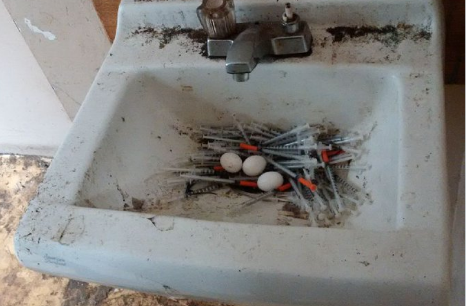Vancouver police superintendent Michelle Davey posted a photograph on Twitter yesterday that has sceptics, reporters and biologists across the country asking about pigeon biology. Would a bird nest in a pile of hypodermic needles?
If there was ever a pointed metaphor for the perilous conditions of the opioid crisis gripping the city, these three eggs are it.
In the neighbourhood, public places and parks are routinely swept for needle trash and debris. Needle exchanges have operated around the city for decades, and earlier this year sharps boxes were installed in all community centres.
Pigeons spotted making a nest out of #needles in a #DTES SRO room. Sad reality of the #opioidcrisis #fentanyl #frontline #notstaged pic.twitter.com/M0DDVLkL28
— Supt. Michelle Davey (@VPDSuperDavey) May 3, 2017
Urban wildlife and birds will use any and all material that replicates the building blocks of their nests, said Maria Egerton, the conservation project manager with the Stanley Park Ecology Society.
"They will adapt to what is in their environment," she said. "It's a good comment with how we should be careful with our refuse. Birds will use all kinds of things to build their nests --- soft, wet leaves to feathers to grass, twigs and large sticks. It really depends on the species and even within one species of bird, sub-species can use different materials.
"Pigeons will use twigs and small sticks, they like a nest that is in a little depression or a nook," she said. "That looks like a nest to me. It's a disturbing image."
Egerton has seen all kinds of plastic, including bags and six-pack rings, weaved into nests.
"In this case, hypodermic needles look like excellent sticks," she said. "That is how I see that photo. With those kins of pigeons, the male brings the nesting material, so that male may have collected those perfect, uniform sticks."
The photograph was taken by a homeless outreach officer in the Downtown Eastside who, according to the superintendent, “saw pigeons fly out of the room” and then photographed the dirty sink with three white eggs nestled among some 30 orange-tipped needles.
The room was vacant of people, Davey told the Courier. Also, the “nest was not staged.”
An average four people are dying each day in British Columbia from overdose deaths because of illicit drugs such as fentanyl and carfentanil, according to the provincial coroners service. The 120 suspected overdose deaths in March marked a 52 per cent increase from the same month last year.
The Vancouver police said the photograph was taken in a single-room occupancy hotel but would not disclose the specific building or address.
“The picture was shared with the public to show the reality of drug use in the Downtown Eastside and to provide a rare glimpse into the lives of first responders, health care providers, and others involved in the opioid crisis,” VPD spokesman Randy Fincham said in an email to the Courier.
“The image was also shared to start a conversation, a conversation about the harm reduction efforts of first responders, and the need for treatment options for substance users.”
Numerous scientists and ornithologists are casting doubt on the veracity the needles are indeed a bird’s nest.
Luc-Alain Giraldeau, a behavioural ecologist and dean of the Faculty of Science at l’Univérsité du Québec à Montréal, told the CBC and the National Post that the nest looks “like a fake” and “cannot be a pigeon nest” because it does not show telltale signs.
Besides almost exclusively laying two eggs, pigeons leave feces and feathers around their nests. Neither are visible on the white sink.
In the same National Post story, however, two U.S. scientists said the sink half filled with needles could not be ruled out as a nest.
“My first reaction was that it looks faked,” Nathaniel Wheelwright said. “But then pigeons do build flimsy platform nests of thick twigs, and house wrens sometimes nest in bags of nails. So, it could be.”



